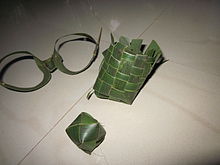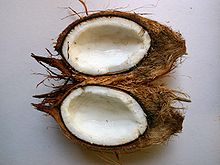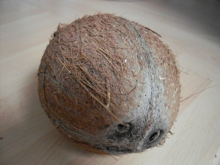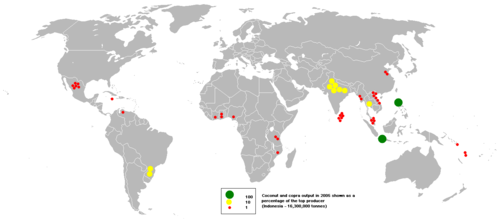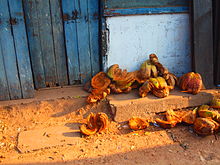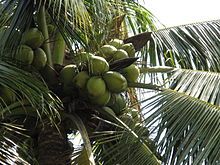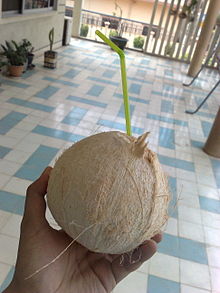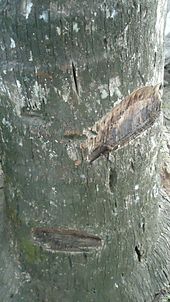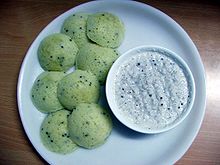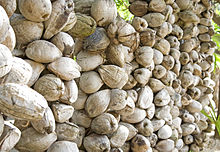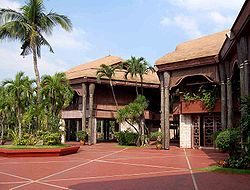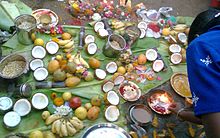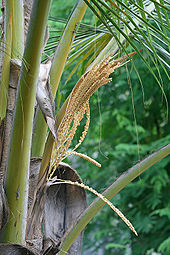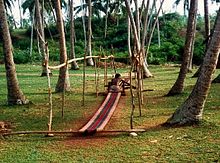- Coconut
-
For other uses, see Coconut (disambiguation).
Coconut Palm
Cocos nucifera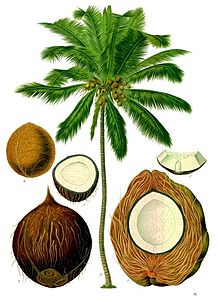
Coconut Palm (Cocos nucifera) Scientific classification Kingdom: Plantae (unranked): Angiosperms (unranked): Monocots[1] (unranked): Commelinids Order: Arecales Family: Arecaceae Subfamily: Arecoideae Tribe: Cocoeae Genus: Cocos Species: C. nucifera' Binomial name Cocos nucifera
L.The coconut palm, Cocos nucifera, is a member of the family Arecaceae (palm family). It is the only accepted species in the genus Cocos.[2] The term coconut can refer to the entire coconut palm, the seed, or the fruit, which is not a botanical nut. The spelling cocoanut is an old-fashioned form of the word.[3] The term is derived from 16th century Portuguese and Spanish cocos, meaning "grinning face", from the three small holes on the coconut shell that resemble human facial features.
Found across much of the tropic and subtropic area, the coconut is known for its great versatility as seen in the many domestic, commercial, and industrial uses of its different parts. Coconuts are part of the daily diet of many people. Its endosperm is known as the edible "flesh" of the coconut; when dried it is called copra. The oil and milk derived from it are commonly used in cooking and frying; coconut oil is also widely used in soaps and cosmetics. The clear liquid coconut water within is a refreshing drink and can be processed to create alcohol. The husks and leaves can be used as material to make a variety of products for furnishing and decorating. It also has cultural and religious significance in many societies that use it.
Description
Plant
Cocos nucifera is a large palm, growing up to 30 meters (98 ft) tall, with pinnate leaves 4–6 meters (13–20 ft) long, and pinnae 60–90 cm long; old leaves break away cleanly, leaving the trunk smooth. Coconuts are generally classified into two general types: tall and dwarf.[4] On very fertile land a tall coconut palm tree can yield up to 75 fruits per year, but more often yields less than 30 mainly due to poor cultural practices.[5] In recent years, improvements in cultivation practices and breeding has produced coconut trees that can yield more.[6][7]
Fruit
Botanically the coconut fruit is a drupe, not a true nut.[8] Like other fruits it has three layers: exocarp, mesocarp, and endocarp. The exocarp and mesocarp make up the husk of the coconut. Coconuts sold in the shops of non-tropical countries often have had the exocarp (outermost layer) removed. The mesocarp is composed of fibers called coir which have many traditional and commercial uses. The shell has three germination pores (stoma) or eyes that are clearly visible on its outside surface once the husk is removed.
A full-sized coconut weighs about 1.44 kilograms (3.2 lb). It takes around 6000 full-grown coconuts to produce a tonne of copra.[9]
Seed
Within the shell is a single seed. When the seed germinates, the root (radicle) of its embryo pushes out through one of the eyes of the shell. The outermost layer of the seed, the testa, adheres to the inside of the shell. In a mature coconut, a thick albuminous endosperm adheres to the inside of the testa. This endosperm or meat is the white and fleshy edible part of the coconut. Although coconut meat contains less fat than many oilseeds and seeds such as almonds, it is noted for its high amount of medium-chain saturated fat.[10] About 90% of the fat found in coconut meat is saturated, a proportion exceeding that of foods such as lard, butter, and tallow. There has been some debate as to whether or not the saturated fat in coconuts is healthier than other forms of saturated fat (see coconut oil). Like most nut meats, coconut meat contains less sugar and more protein than popular fruits such as bananas, apples and oranges. It is relatively high in minerals such as iron, phosphorus and zinc.
The endosperm surrounds a hollow interior space, filled with air and often a liquid referred to as coconut water (distinct from coconut milk). Immature coconuts are more likely to contain coconut water and less meat. They are often sold with a small portion of the husk cut away to allow access to the coconut water. Young coconuts used for coconut water are called tender coconuts. The water of a tender coconut is liquid endosperm. It is sweet (mild) with an aerated feel when cut fresh. Depending on its size a tender contains 300 to 1,000 ml of coconut water.
The meat in a green young coconut is softer and more gelatinous than that in a mature coconut—so much so that it is sometimes known as coconut jelly. When the coconut has ripened and the outer husk has turned brown, a few months later, it will fall from the palm of its own accord. At that time the endosperm has thickened and hardened, while the coconut water has become somewhat bitter.
When the coconut fruit is still green, the husk is very hard, but green coconuts only fall if they have been attacked by molds or other blights. By the time the coconut naturally falls, the husk has become brown, the coir has become drier and softer, and the coconut is less likely to cause damage when it drops, although there have been instances of coconuts falling from palms and injuring people, and claims of some fatalities. This was the subject of a paper published in 1984 that won the Ig Nobel Prize in 2001. Falling coconut deaths are often used as a comparison to shark attacks; the claim is often made that a person is more likely to be killed by a falling coconut than by a shark, yet such evidence as there is would suggest that the number of deaths due to falling coconuts is small.[11][12]
Coconut, meat, raw Nutritional value per 100 g (3.5 oz) Energy 1,481 kJ (354 kcal) Carbohydrates 15.23 g - Sugars 6.23 g - Dietary fiber 9.0 g Fat 33.49 g - saturated 29.70 g - monounsaturated 1.43 g - polyunsaturated 0.37 g Protein 3.3 g Thiamine (vit. B1) 0.066 mg (6%) Riboflavin (vit. B2) 0.02 mg (2%) Niacin (vit. B3) 0.54 mg (4%) Pantothenic acid (B5) 0.300 mg (6%) Vitamin B6 0.054 mg (4%) Folate (vit. B9) 26 μg (7%) Vitamin C 3.3 mg (4%) Calcium 14 mg (1%) Iron 2.43 mg (19%) Magnesium 32 mg (9%) Phosphorus 113 mg (16%) Potassium 356 mg (8%) Zinc 1.1 mg (12%) Percentages are relative to US recommendations for adults.
Source: USDA Nutrient DatabaseA small number of writings about coconuts mention the existence of the coconut pearl.[13] This is generally considered a hoax. Professor Armstrong, of Palomar College, says "most eyewitness records of coconut pearls cited in the literature are secondhand accounts that were not observed by the authors of these articles. There are a few firsthand, published accounts of pearls observed inside coconuts, but these have been shown to be fraudulent."[14]
The shell composition is shown in the tables below.
Coconut shell compound (dry basis) Compound Percent Cellulose 33.61 Lignin 36.51 Pentosans 29.27 Ash 0.61 Source: Jasper Guy Woodroof (1979). "Coconuts: Production, Processing, Products".
2nd ed. AVI Publishing Co. Inc.Coconut shell ash compound Compound Percent K2O 45.01 Na2O 15.42 CaO 6.26 MgO 1.32 Fe2O3 + Al2O3 1.39 P2O5 4.64 SO3 5.75 SiO2 4.64 Source: Jasper Guy Woodroof (1979). "Coconuts: Production, Processing, Products".
2nd ed. AVI Publishing Co. Inc.Roots
Unlike some other plants, the palm tree has neither tap root nor root hairs; but has a fibrous root system.[15]
Inflorescence
On the same inflorescence, the palm produces both the female and male flowers; thus the palm is monoecious.[15] Other sources use the term polygamomonoecious.[16] The female flower is much larger than the male flower. Flowering occurs continuously. Coconut palms are believed to be largely cross-pollinated, although some[which?] dwarf varieties are self-pollinating.
Etymology
One of the earliest mentions of the coconut also dates back to the One Thousand and One Nights story of Sinbad the Sailor, he is known to have bought and sold coconuts during his Fifth Voyage.[17] Tenga was the term used in the detailed description of coconut found in Itinerario by Ludovico di Varthema published in 1510 and also in the later Hortus Indicus Malabaricus.[18] Even earlier it was called nux indica, a name used by Marco Polo in 1280 while in Sumatra, taken from the Arabs who called it جوز هندي jawz hindī. Both names translate to "Indian nut."[19] In the earliest description of the coconut palm known, given by Cosmos of Alexandria in his Topographia Christiana written about 545 A.D., there is a reference to the Argell Tree and its fruit, the great nut of India.[18][20]
Historical evidence favors the European origin of the name "coconut", for there is nothing similar in any of the languages of India, where the Portuguese first found the fruit; and indeed Barbosa, Barros, and Garcia, in mentioning the Malayalam name tenga, and Canarese narle, expressly say 'we call these fruits quoquos', 'our people have given it the name of coco', 'that which we call coco, and the Malabars temga'."
The OED states: "Portuguese and Spanish authors of the 16th c. agree in identifying the word with Portuguese and Spanish coco "grinning face, grin, grimace", also "bugbear, scarecrow", cognate with cocar "to grin, make a grimace"; the name being said to refer to the face-like appearance of the base of the shell, with its three holes. According to Losada, the name came from Portuguese explorers, the sailors of Vasco da Gama in India, who first brought them to Europe. The coconut shell reminded them of a ghost or witch in Portuguese folklore called coco (also côca).[21][22] The first known recorded usage of the term is 1555.[23][24]
The specific name nucifera is Latin for nut-bearing.
Origin and distribution
Origin
 The range of the natural habitat of the coconut palm tree delineated by the red line (based on information in Werth 1933,[25] slightly modified by Niklas Jonsson)
The range of the natural habitat of the coconut palm tree delineated by the red line (based on information in Werth 1933,[25] slightly modified by Niklas Jonsson)
The origin of the plant is the subject of debate.[26][27][28] Many authorities suggest an Indo-Pacific origin either around Melanesia and Malesia or the Indian Ocean, while others see the origin in northwestern South America.[26][27][28] The oldest fossils known of the modern coconut date from the Eocene period from around 37 to 55 million years ago and were found in Australia and India. However, there are older palm fossils like some of nipa fruit that have been found in the Americas.[28]
Distribution
The coconut has spread across much of the tropics, probably aided in many cases by seafaring people. Coconut fruit in the wild is light, buoyant and highly water resistant, and evolved to disperse significant distances via marine currents.[29] It has been collected from the sea as far north as Norway.[30] In the Hawaiian Islands, the coconut is regarded as a Polynesian introduction, first brought to the islands by early Polynesian voyagers from their homelands in Oceania.[19] They have been found in the Caribbean and the Atlantic coasts of Africa and South America for less than 500 years but there is evidence that their presence on the Pacific coast of South America predates Christopher Columbus's arrival in the Americas.[27] They are now almost ubiquitous between 26°N and 26°S except for the interiors of Africa and South America.
Natural habitat
Coconut germinating on Black Sand Beach, Island of Hawaii
The coconut palm thrives on sandy soils and is highly tolerant of salinity. It prefers areas with abundant sunlight and regular rainfall (150 cm to 250 cm annually), which makes colonizing shorelines of the tropics relatively straightforward.[31] Coconuts also need high humidity (70–80%+) for optimum growth, which is why they are rarely seen in areas with low humidity, like the south eastern Mediterranean or Andalusia, even where temperatures are high enough (regularly above 24°C or 75.2°F).
Coconut palms require warm conditions for successful growth, and are intolerant of cold weather. Optimum growth is with a mean annual temperature of 27 °C (81 °F), and growth is reduced below 21 °C (70 °F). Some seasonal variation is tolerated, with good growth where mean summer temperatures are between 28–37 °C (82–99 °F), and survival as long as winter temperatures are above 4–12 °C (39–54 °F); they will survive brief drops to 0 °C (32 °F). Severe frost is usually fatal, although they have been known to recover from temperatures of −4 °C (25 °F).[31] They may grow but not fruit properly in areas where there is not sufficient warmth, like Bermuda.
The conditions required for coconut trees to grow without any care are:
- mean daily temperature above 12–13 °C (53.6–55.4 °F) every day of the year
- 50 year low temperature above freezing
- mean yearly rainfall above 1000 mm (39.37")
- no or very little overhead canopy, since even small trees require a lot of sun
The main limiting factor is that most locations which satisfy the first three requirements do not satisfy the fourth, except near the coast where the sandy soil and salt spray limit the growth of most other trees.
Diseases
Main article: List of coconut palm diseasesCoconuts are susceptible to the phytoplasma disease lethal yellowing. One recently selected cultivar, the Maypan, has been bred for resistance to this disease.
Pests
The coconut palm is damaged by the larvae of many lepidoptera (butterfly and moth) species which feed on it, including Batrachedra spp: B. arenosella, B. atriloqua (feeds exclusively on Cocos nucifera), B. mathesoni (feeds exclusively on Cocos nucifera), and B. nuciferae.
Brontispa longissima (the "coconut leaf beetle") feeds on young leaves and damages seedlings and mature coconut palms. In 2007, the Philippines imposed a quarantine in Metro Manila and 26 provinces to stop the spread of the pest and protect the $800 million Philippine coconut industry.[32]
The fruit may also be damaged by eriophyid coconut mites (Eriophyes guerreronis). This mite infests coconut plantations, and is devastating: it can destroy up to 90% of coconut production. The immature nuts are infested and desapped by larvae staying in the portion covered by the perianth of the immature nut; the nuts then drop off or survive deformed. Spraying with wettable sulfur 0.4% or with neem-based pesticides can give some relief, but is cumbersome and labor intensive.
In Kerala the main coconut pests are the coconut mite, the rhinoceros beetle, the red palm weevil and the coconut leaf caterpillar. Research on this topic has as of 2009[update] produced no results, and researchers from the Kerala Agricultural University and the Central Plantation Crop Research Institute, Kasaragode are still searching for a cure. The Krishi Vigyan Kendra, Kannur under Kerala Agricultural University has developed an innovative extension approach called compact area group approach (CAGA) to combat coconut mites.
Cultivation
Top ten coconut producers — 19 December 2009 Country Production (tonnes) Footnote  Philippines
Philippines19,500,000 *  Indonesia
Indonesia15,319,500  India
India10,894,000  Brazil
Brazil2,759,044  Sri Lanka
Sri Lanka2,200,000 F  Thailand
Thailand1,721,640 F  Mexico
Mexico1,246,400 F  Vietnam
Vietnam1,086,000 A  Papua New Guinea
Papua New Guinea677,000 F  Malaysia
Malaysia555,120  Tanzania
Tanzania370,000 F World 54,716,444 A No symbol = official figure, P = official figure, F = FAO estimate,
* = Unofficial/Semi-official/mirror data, C = Calculated figure,
A = Aggregate (may include official, semi-official or estimates);
Coconut palms are grown in more than 80 countries of the world, with a total production of 61 million tonnes per year.[33] Coconut trees are very hard to establish in dry climates, and cannot grow there without frequent irrigation; in drought conditions, the new leaves do not open well, and older leaves may become desiccated; fruit also tends to be shed.[31]
The extent of cultivation in the tropics is threatening a number of habitats such as mangroves; an example of such damage to an ecoregion is in the Petenes mangroves of the Yucatan.[34]
Harvesting
In some parts of the world (Thailand and Malaysia), trained pig-tailed macaques are used to harvest coconuts. Training schools for pig-tailed macaques still exist both in southern Thailand, and in the Malaysian state of Kelantan.[35] Competitions are held each year to find the fastest harvester.
India
Traditional areas of coconut cultivation in India are the states of Kerala, Tamil Nadu, Karnataka, Goa, Andhra Pradesh, Orissa, West Bengal, Pondicherry, Maharashtra and the islands of Lakshadweep and Andaman and Nicobar. Four southern states put together account for almost 92% of the total production in the country: Kerala (45.22%), Tamil Nadu (26.56%), Karnataka (10.85%), and Andhra Pradesh (8.93%).[36] Other states like Goa, Maharashtra, Orissa, West Bengal, and those in the northeast like Tripura and Assam account for the remaining 8.44%. Kerala, which has the largest number of coconut trees, is famous for its coconut-based products like coconut water, copra, coconut oil, coconut cake (also called coconut meal, copra cake, or copra meal), coconut toddy, coconut shell-based products, coconut wood-based products, coconut leaves, and coir pith.
The Southern Indian state of Kerala is named after the coconut tree. "Kera" = Coconut tree, "Alam" = Land: so "Land of Coconut Trees" Various terms like Copra, Coir are derived from the native Malayalam language. In Kerala, coconut tree is called as "Kalpa Vriksham" which essentially means all parts of a Coconut tree is useful some way or other.
Maldives
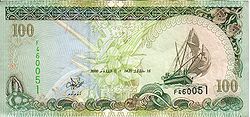 Green coconut fruit strands on the tree are featured on each Maldivian rufiyaa banknote
Green coconut fruit strands on the tree are featured on each Maldivian rufiyaa banknote
The coconut is the national tree of the Maldives and is considered the most important plant in the country. A coconut tree is also included in the country's national emblem or coat of arms. Coconut trees are grown on all the islands. Before modern construction methods were introduced to the Maldives, coconut leaves were used as a roofing material for many houses in the islands while coconut timber was used to build houses and boats.
Middle East
The main coconut producing area in the Middle East is the Dhofar region of Oman. However, they can be grown all along the Persian Gulf coast, Arabian Sea and Red Sea coast because these seas are tropical and provide enough humidity (through sea water evaporation) for coconut trees to grow. The young coconut plants need to be nursed and irrigated with drip pipes until they are old enough (stem bulb development) to be irrigated with brackish water or sea water alone, after which they can be replanted on the beaches. In particular, the area around Salalah maintains large coconut plantations similar to those found across the Arabian Sea in Kerala. The reasons why coconut are cultivated only in Yemen's Al Mahrah and Hadramaut governorates and in the Sultanate of Oman, but not in other suitable areas in the Arabian Peninsula, may originate from the fact that Oman and Hadramaut had long dhow trade relations with Burma, Malaysia, Indonesia, East Africa and Zanzibar as well as southern India and China. Omani people needed the coir rope from the coconut fiber rope to stitch together their traditional high sea going dhow vessels in which nails were never used. The 'know how' of coconut cultivation and necessary soil fixation and irrigation may have found its way into Omani and Hadrami and Al-Mahra culture by people who returned from those oversea areas.
The coconut cultivars grown in Oman are generally of the drought-resistant Indian "West Coast tall" (WC Tall) variety. Unlike the UAE, which grows mostly non-native dwarf or hybrid coconut cultivars imported from Florida for ornamental purposes, the slender tall Omani coconut cultivars are relatively well adapted to the Middle East's hot dry seasons, but need longer to reach maturity. The Middle East's hot, dry climate favors the development of coconut mites, which cause immature nut dropping and may cause brownish gray discoloration on the coconut's outer green fiber.
The ancient coconut groves of Dhofar were mentioned by the medieval Moroccan traveller Ibn Battuta in his writings, known as Al Rihla.[37] The annual rainy season known locally as Khareef or Monsoon makes coconut cultivation easy on the Arabian east coast.
Coconut trees also are increasingly grown for decorative purposes along the coasts of the UAE and Saudi Arabia with the help of irrigation. The UAE has, however, imposed strict laws on mature coconut tree imports from other countries to reduce the spread of pests to other native palm trees, as the mixing of date and coconut trees poses a risk of cross species palm pests, such as rhinoceros beetle and red palm weevil.[38] The artificial landscaping adopted in Florida may have been the cause for lethal yellowing, a viral coconut palm disease that leads to the death of the tree. It is spread by host insects, that thrive on heavy turf grasses. Therefore heavy turf grass environments (beach resorts and golf courses) also pose a major threat to local coconut trees. Traditionally, dessert banana plants and local wild beach flora such as Scaevola taccada and Ipomoea pes-caprae were used as humidity supplying green undergrowth for coconut trees, mixed with sea almond and sea hibiscus. Due to growing sedentary life style and heavy handed landscaping, there has been a decline in these traditional farming and soil fixing techniques.
Sri Lanka
An early mention of the planting of coconuts is found in the Mahavamsa during the reign of Agrabodhi II around 589 A.D.[18] Coconuts are common in the Sri Lankan diet and the main source of dietary fat.[39] Sri Lanka is home to the Coconut Research Institute of Sri Lanka.
United States of America
The only places in the U.S. where coconut palms can be grown and reproduced outdoors without irrigation are Hawaii, south Florida and the U.S. territories of Puerto Rico, Guam, American Samoa, Virgin Islands and the Commonwealth of the Northern Mariana Islands. Coconut palms will grow from coastal Pinellas County and St. Petersburg southwards on Florida's west coast, and Melbourne southwards on Florida's east coast. The occasional coconut palm is seen north of these areas in favored microclimates in the Tampa and Clearwater metro area and around Cape Canaveral, as well as the Orlando-Kissimmee-Daytona Beach metro area. They may likewise be grown in favored microclimates in the Rio Grande Valley area of Deep South Texas near Brownsville and on the upper northeast Texas Coast at Galveston Island. They may reach fruiting maturity, but are damaged or killed by the occasional winter freezes in these areas. Most of the coconut palms, even full grown specimens, in central Florida that were not adjacent to water were killed by the freeze event in January 2010. Even those on the water were damaged, but are recovering. While coconut palms flourish in south Florida, unusually bitter cold snaps can kill or injure coconut palms there as well. Only the Florida Keys and the coastlines provide safe havens from the cold for growing coconut palms on the U.S. mainland.[citation needed] The farthest north in the United States a coconut palm has been known to grow outdoors is in Newport Beach, California along the Pacific Coast Highway. For coconut palms to survive in Southern California, they need sandy soil and minimal water in the winter to prevent root rot, and would benefit from root heating coils.[citation needed]
Australia
Coconuts are commonly grown around the north coast of Australia. They can be grown in some warmer parts of New South Wales.
Bermuda
Coconuts can be grown with care in Bermuda, but cooler temperatures in winter prevent most of them from successfully producing fruit.
Cooler climates
In cooler climates (but not less than USDA Zone 9), a similar palm, the queen palm (Syagrus romanzoffiana), is used in landscaping. Its fruits are very similar to the coconut, but much smaller. The queen palm was originally classified in the genus Cocos along with the coconut, but was later reclassified in Syagrus. A recently discovered palm, Beccariophoenix alfredii from Madagascar, is nearly identical to the coconut, more so than the queen palm and can also be grown in slightly cooler climates than the coconut palm. Coconuts can only be grown in temperatures above 64 degrees, but need a daily temperature above 72 degrees in order to produce fruit. Most of the cooler areas in mid-Florida can produce coconuts, but with little or no fruit production
Overview of uses
The coconut palm is grown throughout the tropics for decoration, as well as for its many culinary and non-culinary uses; virtually every part of the coconut palm can be utilized by humans in some manner. Coconuts' versatility is sometimes noted in its naming. In Sanskrit it is kalpa vriksha ("the tree which provides all the necessities of life"). In the Malay language, it is pokok seribu guna ("the tree of a thousand uses"). In the Philippines, the coconut is commonly called the "Tree of Life".[40] Nearly all parts of the palm are useful, and it has significant economic value.
Culinary use
The various parts of the coconut have a number of culinary uses. The nut provides oil for frying, cooking, and making margarine. The white, fleshy part of the seed—the coconut meat—is edible and used fresh or dried in cooking especially in confections and desserts like macaroons. Desiccated coconut can be used as an ingredient or to produce coconut milk which is frequently added to curry dishes and other savory viands. Coconut flour has also been developed for use in baking and to combat malnutrition.[41] Coconut chips have been sold in tourist regions like Hawaii and the Caribbean. Coconut butter is often used to describe solidified coconut oil, but has also been adopted as a name by certain specialty products made out of coconut milk solids or puréed coconut meat and oil.
Coconut water
Main article: Coconut waterCoconut water contains sugar, fiber, proteins, antioxidants, vitamins and minerals, and provides an isotonic[citation needed] electrolyte balance. It is consumed as a refreshing drink throughout the humid tropics and is gaining popularity as an isotonic sports drink. Mature fruits have significantly less liquid than young immature coconuts, barring spoilage. Coconut water can be fermented to produce coconut vinegar.
Coconut milk
Main article: Coconut milkCoconut milk, not to be confused with coconut water, is obtained primarily by extracting juice by pressing the grated coconut's white kernel or by passing hot water or milk through grated coconut, which extracts the oil and aromatic compounds. It has a fat content around 17%.[citation needed] When refrigerated and left to set, coconut cream will rise to the top and separate from the milk. The milk can be used to produce virgin coconut oil by controlled heating and removal of the oil fraction.
Toddy and nectar
The sap derived from incising the flower clusters of the coconut is drunk as neera also known as toddy or tuba (Philippines), tuak (Indonesia and Malaysia) or karewe (fresh and not fermented, collected twice a day, for breakfast and dinner) in Kiribati. When left to ferment on its own it becomes palm wine. Palm wine is distilled to produce arrack. In the Philippines this alcoholic drink is called lambanog or "coconut vodka".[42]
The sap can be reduced by boiling to create a sweet syrup or candy such as te kamamai in Kiribati or dhiyaa hakuru and Addu bondi in Maldives. It can be reduced further to yield coconut sugar also referred to as palm sugar or jaggery. A young well-maintained tree can produce around 300 liters (66 imp gal; 79 U.S. gal) of toddy per year while a forty year old tree may yield around 400 litres (88 imp gal; 110 US gal).[43]
Heart of palm and coconut sprout
Apical buds of adult plants are edible, and are known as "palm cabbage" or heart of palm. They are considered a rare delicacy, as harvesting the buds kills the palms. Hearts of palm are eaten in salads, sometimes called "millionaire's salad". Newly germinated coconuts contain an edible fluff of marshmallow-like consistency called coconut sprout, produced as the endosperm nourishes the developing embryo.
Philippines
In the Philippines, rice is wrapped in coconut leaves for cooking and subsequent storage; these packets are called puso. Coconut milk, known as gata, and grated coconut flakes are used in the preparation of dishes like laing, ginataan, bibingka, ube halaya, pitsi-pitsi, palitaw, buko pie and more. Coconut jam is made by mixing muscovado sugar with coconut milk. Coconut sport fruits are also harvested. One such variety of coconut is known as macapuno. Its meat is sweetened, cut into strands and sold in glass jars as coconut strings and sometimes labeled "gelatinous mutant coconut". Coconut water can be fermented to make a different gelatinous product nata de coco also called coconut gel.
Vietnam
In Vietnam, coconut is grown mainly in Ben Tre Province, often called the "land of the coconut". It is used to make coconut candy, caramel and jelly. Coconut juice and coconut milk are used, especially in Vietnam's Southern style of cooking, including kho and chè.
India
In Kerala, the most common way of cooking vegetables is to add grated coconut and then steam them with spices after frying in a little oil. People from Kerala also make chutney, which involves grinding the coconut with salt, chillies, and whole spices. The uruttu chammanthi as the granulated chutney is known is eaten with rice or kanji (rice gruel). It is also invariably the main side dish served with idli, vadai, and dosai. Coconut ground with spices is also mixed in sambar and other various lunch dishes for extra taste. Dishes that are garnished with grated coconut are generally referred to as poduthol in North Malabar and thoran in rest of Kerala. Puttu is a culinary delicacy of Kerala and Tamil Nadu, in which layers of coconut alternate with layers of powdered rice, all of which fit into a bamboo stalk. In recent times this has been replaced with steel or aluminium tubes, which is then steamed over a pot. Coconut (Tamil: தேங்காய்) is regularly broken in the middle class families in Tamil Nadu for food. Coconut meat can be eaten as a snack sweetened with jaggery or molasses.
Commercial, industrial, and household use
Coir
Coir (the fiber from the husk of the coconut) is used in ropes, mats, brushes, sacks, caulking for boats and as stuffing fiber for mattresses.[44] It is used in horticulture in potting compost, especially in orchid mix.
Coconut leaves
The stiff mid-ribs of coconut leaves are used for making brooms in India, Indonesia and Malaysia (called sapu lidi in Indonesia). The green of the leaves (lamina) are stripped away leaving the vein (a wooden-like, thin, long strip) which are tied together to form a broom or brush. A long handle made from some other wood may be inserted into the base of the bundle and used as a two-handed broom. The leaves also provide material for baskets that can draw well water and for roofing thatch; they can be woven into mats, cooking skewers, and kindling arrows as well. Two leaves (especially the younger, yellowish shoots) weaved into a tight shell the size of the palm are filled with rice and cooked to make ketupat.[45] Dried coconut leaves can be burned to ash, which can be harvested for lime. In India, particularly in Kerala, Karnataka and Tamil Nadu, the woven coconut leaves are used as 'pandals' (temporary sheds) for the marriage functions.
Copra
Main articles: Copra and Coconut oilCopra is the dried meat of the seed and after processing produces coconut oil and coconut meal. Coconut oil, aside from being used in cooking as an ingredient and for frying, is used in soaps and cosmetics. In Vanuatu coconut palms for copra production are generally spaced 9 meters apart, allowing a tree density of 100–160 trees per hectare.
Husks and shells
The husk and shells can be used for fuel and are a source of charcoal. Activated carbon manufactured from coconut shell is considered[by whom?] superior to those obtained from other sources, mainly because of small macropores structure which renders it more effective[weasel words] for the adsorption of gas and vapor and for the removal of color, oxidants, impurities and odor of compounds.
A dried half coconut shell with husk can be used to buff floors. It is known as a bunot in the Philippines and simply a "coconut brush" in Jamaica. The fresh husk of a brown coconut may serve as a dish sponge or body sponge. Tempurung as the shell is called in the Malay language can be used as a soup bowl and—if fixed with a handle—a ladle. In India, coconut shells are also used as bowls and in the manufacture of various handicrafts, including buttons carved out of dried coconut shell. Coconut buttons are often used for Hawaiian Aloha shirts. In Thailand, the coconut husk is used as a potting medium to produce healthy forest tree saplings. The process of husk extraction from the coir bypasses the retting process, using a custom-built coconut husk extractor designed by ASEAN-Canada Forest Tree Seed Centre (ACFTSC) in 1986. Fresh husks contains more tannin than old husks. Tannin produces negative effects on sapling growth.[46] In parts of South India, the shell and husk are burned for smoke to repel mosquitoes.
Half coconut shells are used in theatre Foley sound effects work, banged together to create the sound effect of a horse's hoofbeats. Dried half coconut shells are used as the bodies of musical instruments, including the Chinese yehu and banhu, along with the Vietnamese đàn gáo and Arabo-Turkic rebab. In the Philippines, dried half shells are also used as a music instrument in a folk dance called maglalatik.
In World War II, coastwatcher scout Biuki Gasa was the first of two from the Solomon Islands to reach the shipwrecked, wounded, and exhausted crew of Motor Torpedo Boat PT-109 commanded by future U.S. president John F. Kennedy. Gasa suggested, for lack of paper, delivering by dugout canoe a message inscribed on a husked coconut shell. This coconut was later kept on the president's desk, and is now in the John F. Kennedy Library.[citation needed]
Coconut trunk
Coconut trunks are used for building small bridges; they are preferred for their straightness, strength and salt resistance. In Kerala (India), coconut trunks are used for house construction. Coconut timber comes from the trunk, and is increasingly being used as an ecologically sound substitute for endangered hardwoods. It has applications in furniture and specialized construction, as notably demonstrated in Manila's Coconut Palace.
Hawaiians hollowed the trunk to form drums, containers, or small canoes. The "branches" (leaf petioles) are strong and flexible enough to make a switch. The use of coconut branches in corporal punishment was revived in the Gilbertese community on Choiseul in the Solomon Islands in 2005.[47]
Coconut roots
The roots are used as a dye, a mouthwash, and a medicine for diarrhea[5] and dysentery. A frayed piece of root can also be used as a toothbrush.
Role in culture and religion
In the Ilocos region of northern Philippines, the Ilocano people fill two halved coconut shells with diket (cooked sweet rice), and place liningta nga itlog (halved boiled egg) on top of it. This ritual is known as niniyogan and is an offering made to the deceased and one's past ancestors. This accompanies the palagip (prayer to the dead).
A coconut (Sanskrit: narikela) is an essential element of rituals in Hindu tradition. Often it is decorated with bright metal foils and other symbols of auspiciousness. It is offered during worship to a Hindu god or goddess. Irrespective of their religious affiliation, fishermen of India often offer it to the rivers and seas in the hopes of having bountiful catches. Hindus often initiate the beginning of any new activity by breaking a coconut to ensure the blessings of the gods and successful completion of the activity. The Hindu goddess of well-being and wealth, Lakshmi, is often shown holding a coconut.[48] In the foothills of the temple town of Palani, before going to worship Murugan for the Ganesha, coconuts are broken at a place marked for the purpose. Every day, thousands of coconuts are broken, and some devotees break even 108 coconuts at a time as per the prayer. In tantric practices, coconuts are sometimes used as substitutes for human skulls.
In Hindu wedding ceremonies, a coconut is placed over the opening of a pot, representing a womb. Coconut flowers are auspicious symbols and are fixtures at Hindu and Buddhist weddings and other important occasions. In Kerala, coconut flowers must be present during a marriage ceremony. The flowers are inserted into a barrel of unhusked rice (paddy) and placed within sight of the wedding ceremony. Similarly in Sri Lanka coconut flowers, standing in brass urns, are placed in prominent positions.
The Zulu Social Aid and Pleasure Club of New Orleans traditionally throws hand decorated coconuts—the most valuable of Mardi Gras souvenirs—to parade revelers. The "Tramps" began the tradition ca. 1901. In 1987, a "coconut law" was signed by Gov. Edwards exempting from insurance liability any decorated coconut handed from a Zulu float.
The coconut is also used as a target and prize in the traditional British fairground game "coconut shy". The player buys some small balls which he throws as hard as he can at the coconuts which are balanced on sticks. The aim is to knock a coconut off the stand and win it.
Medicinal uses
Coconuts may help benign prostatic hyperplasia.[49] In rats, virgin coconut oil reduced total cholesterol, triglycerides, phospholipids, LDL, and VLDL cholesterol levels and increased HDL cholesterol in serum and tissues.[50] The hexane fraction of coconut peel may contain novel anticancer compounds.[51] Young coconut juice has estrogen-like characteristics.[52] Inside a coconut is a cavity filled with coconut water, which is sterile until opened. It mixes easily with blood, and was used during World War II in emergency transfusions.[53] It can also serve as an emergency short-term intravenous hydration fluid.[54] This is possible because the coconut water has a high level of sugar and other salts that makes it possible to be used in the bloodstream, much like the modern lactated ringer solution or a dextrose/water solution as an IV. Coconut is also commonly used as a traditional remedy in Pakistan to treat bites from rats.[citation needed] In Brazil coconut is known as coco-da-Bahia or coqueiro-da-India. The tea from the husk fiber is widely used to treat several inflammatory disorders.[55]
Other uses
The leftover fiber from coconut oil and coconut milk production—coconut meal—is used as livestock feed. The dried calyx of the coconut is used as fuel in wood fired stoves. Coconut water is traditionally used as a growth supplement in plant tissue culture/micropropagation.[56] The smell of coconuts comes from the 6-pentyloxan-2-one molecule, known as delta-decalactone in the food and fragrance industry.[57]
Tool and shelter for animals
Researchers from the Melbourne Museum in Australia observed the octopus species Amphioctopus marginatus' use of tools, specifically coconut shells, for defense and shelter. The discovery of this behavior, observed in Bali and North Sulawesi in Indonesia between 1998 and 2008, was published in the journal Current Biology in December 2009.[58][59][60] Amphioctopus marginatus is the first invertebrate known to be able to use tools.[59][61]
A coconut can be hollowed out and used as a home for a rodent or small birds. Halved, drained coconuts can also be hung up as bird feeders, and after the flesh has gone, can be filled with fat in winter to attract tits.
Allergies
Food allergies
Coconut can be a food allergen. It is a top five food allergy in India where coconut is a common food source.[62] On the other hand, food allergies to coconut are considered rare in Australia, the U.K., and U.S.[63] As a result, commercial extracts of coconut are not currently available for skin prick testing in Australia or New Zealand.[64]
Despite a low prevalence of allergies to coconut in the U.S., the U.S. Food and Drug Administration (FDA) began identifying coconut as a tree nut in October 2006.[63] Based on FDA guidance and federal U.S. law, coconut must be disclosed as an ingredient.[65]
Topical allergies
Coconut-derived products can cause contact dermatitis. They can be present in cosmetics including some hair shampoos, moisturizers, soaps, cleansers and hand washing liquids. Coconut-derived products known to cause contact dermatitis include: coconut diethanolamide, cocamide sulphate, cocamide DEA, CDEA, Sodium Laureth Sulfate, Sodium Lauroyl Sulfate, Ammonium Laureth Sulfate, Ammonium Lauryl Sulfate, Sodium Lauroyl Sarcosinate, Sodium Cocoyl Sarcosinate, Potassium Coco Hydrolysed Collagan, TEA Triethanolamin Laureth Sulfate, Caprylic/Capric Triglyceride, Also watch TEA compounds (Triethanolamine) Laureth Sulfate, Lauryl or Cocoyl Sarcosime, Disodium Oleamide Sulfocuccina, Laureth Sulfasuccinate & Disodium Dioctyl Sulfosuccinate.[64]
See also
- Coconut charcoal
- Coir Board of India
- Voanioala gerardii – Forest coconut, the closest relative of the modern coconut
References
- ^ Hahn, William J. (1997). Arecanae: The palms. Retrieved April 4, 2011 from the Tree of Life Web Project website.
- ^ Royal Botanic Gardens, Kew. Cocos. World Checklist of Selected Plant Families.
- ^ J. Pearsall, ed (1999). "Cocoanut". Concise Oxford Dictionary (10th ed.). Oxford: Clarendon Press. ISBN 0-19-860287-1.
- ^ T. Pradeepkumar, B. Sumajyothibhaskar, and K.N. Satheesan. (2008). Management of Horticultural Crops (Horticulture Science Series Vol.11, 2nd of 2 Parts). New India Publishing. pp. 539–587. ISBN 9788189422493.
- ^ a b Grimwood 1975, p. 18.
- ^ Sarian, Zac B. (August 18, 2010). New coconut yields high. The Manila Bulletin. Retrieved April 21, 2011.
- ^ Ravi, Rajesh. (March 16, 2009). Rise in coconut yield, farming area put India on top. The Financial Express. Retrieved April 21, 2011.
- ^ Coconut, Plant of Many Uses. From UCLA course on Economic Botany.
- ^ Bourke, R. Michael and Tracy Harwood (Eds.). (2009). Food and Agriculture in Papua New Guinea. Australian National University. p. 327. ISBN 9781921536601.
- ^ "Nutrition Facts and Information for Vegetable oil, coconut". Nutritiondata.com. http://www.nutritiondata.com/facts-C00001-01c208C.html. Retrieved 2009-12-06.
- ^ Adams, Cecil. (July 19, 2002). Are 150 people killed each year by falling coconuts?. The Straight Dope. Retrieved April 14, 2011.
- ^ Dr. Peter Barss (1984). Deaths from falling Coconuts. Journal of Trauma, vol. 24, no. 11, pp 990-1. Retrieved June 5, 2011.
- ^ Child, Reginald. (1974). Coconuts (2nd edition). London: Longman Group Ltd.
- ^ Armstrong, W.P. (3 April 2008). "Botanical Record-Breakers, 19. The Most Valuable Botanical Jewels". http://waynesword.palomar.edu/ww0601c.htm. Retrieved 9 December 2010.
- ^ a b Thampan, P.K. (1981). Handbook on Coconut Palm. Oxford & IBH Publishing Co.
- ^ Willmer, Pat. (2011). Pollination and Floral Ecology. Princeton University Press. p. 57. ISBN 9780691128610.
- ^ http://classiclit.about.com/library/bl-etexts/arabian/bl-arabian-5sindbad.htm
- ^ a b c Grimwood 1975, p. 1.
- ^ a b Elzebroek, A.T.G. and Koop Wind (Eds.). (2008). Guide to Cultivated Plants. CABI. pp. 186–192. ISBN 9781845933562.
- ^ Rosengarten, Frederic, Jr. (2004). The Book of Edible Nuts. Dover Publications. pp. 65–93. ISBN 9780486434995.
- ^ Losada, Fernando Díez. (2004). La tribuna del idioma. Editorial Tecnologica de CR. p. 481. ISBN 9789977661612. (Spanish)
- ^ Figueiredo, Cândido. (1940). Pequeno Dicionário da Lingua Portuguesa. Livraria Bertrand. Lisboa. (Portuguese)
- ^ "Coco". Merriam-Webster. http://www.merriam-webster.com/dictionary/coco. Retrieved August 28, 2011.
- ^ "Coco". Online Etymology Dictionary. http://www.etymonline.com/index.php?term=coco. Retrieved August 28, 2011.
- ^ Werth, E. (1933). Distribution, Origin and Cultivation of the Coconut Palm. Ber. Deutschen Bot. Ges., vol 51, pp. 301–304. (article translated into English by Dr. R. Child, Director, Coconut Research Scheme, Lunuwila, Sri Lanka).
- ^ a b Grimwood, Brian E., F. Ashman, D.A.V. Dendy, C.G. Jarman, E.C.S. Little, and W.H. Timmins. (1975). Coconut Palm Products – Their processing in developing countries. Rome: FAO. pp. 3–4. ISBN 9789251008539.
- ^ a b c Perera, Lalith, Suriya A.C.N. Perera, Champa K. Bandaranayake and Hugh C. Harries. (2009). "Chapter 12 – Coconut". In Johann Vollmann and Istvan Rajcan (Eds.). Oil Crops. Springer. pp. 370–372. ISBN 9780387775937.
- ^ a b c Jackson, Eric. (August 20 - September 2, 2006). From whence come coconuts?. The Panama News (Volume 12, Number 16). Retrieved April 10, 2011.
- ^ Foale, Mike. (2003). The Coconut Odyssey – the bounteous possibilities of the tree of life. Australian Centre for International Agricultural Research. Retrieved 2009-05-30.
- ^ Ferguson, John. (1898). All about the "coconut palm" (Cocos nucifera) (2nd edition).
- ^ a b c Chan, Edward and Craig R. Elevitch. (April 2006). Cocos nucifera (coconut) (version 2.1). In C.R. Elevitch (Ed.). Species Profiles for Pacific Island Agroforestry. Hōlualoa, Hawai‘i: Permanent Agriculture Resources (PAR).
- ^ Remo, Amy R. (September 27, 2007). Beetles infest coconuts in Manila, 26 provinces. Philippine Daily Inquirer.
- ^ Food And Agriculture Organization of the United Nations. Economic And Social Department. Statistics Division. (September 2, 2010). FAOSTAT – Production – Crops [Selected annual data]. Retrieved April 14, 2011 from the FAOSTAT Database.
- ^ World Wildlife Fund. (December 17, 2010). Petenes mangroves. In Mark McGinley, C. Michael Hogan & Cutler J. Cleveland Encyclopedia of Earth. Washington, D.C.: Environmental Information Coalition, National Council for Science and the Environment. Retrieved April 14, 2011.
- ^ Bertrand, Mireille. (January 27, 1967). Training without Reward: Traditional Training of Pig-tailed Macaques as Coconut Harvesters. Science 155 (3761): 484–486.
- ^ Department of Agriculture Karshika Keralam. Government of Kerala. India. (n.d.). "Coconut Cultivation". http://www.keralaagriculture.gov.in/htmle/bankableagriprojects/ph/coconut.htm. Retrieved 2009-12-06.
- ^ Halsall, Paul. (Ed). (February 21, 2001). "Medieval Sourcebook: Ibn Battuta: Travels in Asia and Africa 1325–1354". Fordham University Center for Medieval Studies. http://www.fordham.edu/halsall/source/1354-ibnbattuta.html. Retrieved April 14, 2011.
- ^ Kaakeh, Walid, Fouad El-Ezaby, Mahmoud M. Aboul-Nour, and Ahmed A. Khamis (2001). "Management of the red palm weevil, Rhynchophorus ferrugineus Oliv., by a pheromone/food-based trapping system" (PDF). http://www.pubhort.org/datepalm/datepalm2/datepalm2_38.pdf. Retrieved 2009-12-06.
- ^ Kaunitz, H. (1986). "Medium chain triglycerides (MCT) in aging and arteriosclerosis". Journal of Environmental Pathology, Toxicology and Oncology : official organ of the International Society for Environmental Toxicology and Cancer 6 (3–4): 115–121. PMID 3519928.
- ^ Margolis, Jason. (December 13, 2006). Coconut fuel. PRI's The World. Retrieved April 10, 2011.
- ^ Grimwood 1975, p. 182.
- ^ Porter, Jolene V. (2005). "Lambanog: A Philippine Drink". Washington D.C.: American University. http://www1.american.edu/ted/lambanog.htm. Retrieved April 10, 2011.
- ^ Grimwood 1975, p. 20.
- ^ Grimwood 1975, p. 22.
- ^ Grimwood 1975, p. 19.
- ^ Somyos Kijkar. "Handbook: Coconut husk as a potting medium". ASEAN-Canada Forest Tree Seed Centre Project 1991, Muak-Lek, Saraburi, Thailand. ISBN 974-3612-77-1.
- ^ Herming, George. (March 6, 2006). Wagina whips offenders. Solomon Star.
- ^ Dallapiccola, Anna. Dictionary of Hindu Lore and Legend. ISBN 0-500-51088-1.
- ^ de Lourdes Arruzazabala, M.; Molina, V.; Más, R.; Carbajal, D.; Marrero, D.; González, V.; Rodríguez, E. (2007). "Effects of coconut oil on testosterone-induced prostatic hyperplasia in Sprague-Dawley rats". Journal of Pharmacy and Pharmacology 59 (7): 995–999. doi:10.1211/jpp.59.7.0012. PMID 17637195.
- ^ Beneficial effects of virgin coconut oil on lipid parameters and in vitro LDL oxidation. Nevin KG. Rajamohan T. Clinical Biochemistry. 37(9):830-5, 2004 Sep. [Comparative Study. Journal Article] UI: 15329324 Authors Full Name Nevin, K G. Rajamohan, T.
- ^ Investigation of fruit peel extracts as sources for compounds with antioxidant and antiproliferative activities against human cell lines. Khonkarn R. Okonogi S. Ampasavate C. Anuchapreeda S. Food & Chemical Toxicology. 48(8-9):2122-9, 2010 Aug-Sep. [Journal Article. Research Support, Non-U.S. Gov't] UI: 20510336 Authors Full Name Khonkarn, Ruttiros. Okonogi, Siriporn. Ampasavate, Chadarat. Anuchapreeda, Songyot.
- ^ Young coconut juice significantly reduces histopathological changes in the brain that are induced by hormonal imbalance: a possible implication to postmenopausal women. Radenahmad N. Saleh F. Sawangjaroen K. Rundorn W. Withyachumnarnkul B. Connor JR. Histology & Histopathology. 24(6):667-74, 2009 Jun. [Journal Article. Research Support, Non-U.S. Gov't] UI: 19337965 Authors Full Name Radenahmad, N. Saleh, F. Sawangjaroen, K. Rundorn, W. Withyachumnarnkul, B. Connor, J R.
- ^ Eiseman, B., R.E. Lozano, and T. Hager. (1954). Clinical Experience in Intravenous Administration of Coconut Water. In A.M.A. Archives of Surgery.
- ^ The intravenous use of coconut water. Campbell-Falck D. Thomas T. Falck TM. Tutuo N. Clem K. American Journal of Emergency Medicine. 18(1):108-11, 2000 Jan. [Case Reports. Journal Article] UI: 10674546 Authors Full Name Campbell-Falck, D. Thomas, T. Falck, T M. Tutuo, N. Clem, K.
- ^ Rinaldi, Sebastian. Silva, Davi O. Bello, Fabiana. Alviano, Celuta S. Alviano, Daniela S. Matheus, Maria Eline. Fernandes, Patricia D. (April 21, 2009). Characterization of the antinociceptive and anti-inflammatory activities from Cocos nucifera L. (Palmae). Journal of Ethnopharmacology 122 3: 541-6. PMID 19429325.
- ^ The chemical composition and biological properties of coconut (Cocos nucifera L.) water. [Review] [110 refs] Yong JW. Ge L. Ng YF. Tan SN. Molecules. 14(12):5144-64, 2009.
- ^ Data sheet about delta-decalactone and its properties
- ^ Finn, Julian K.; Tregenza, Tom; Norman, Mark D. (2009). "Defensive tool use in a coconut-carrying octopus". Curr. Biol. 19 (23): R1069–R1070. doi:10.1016/j.cub.2009.10.052. PMID 20064403.
- ^ a b Gelineau, Kristen (2009-12-15). "Aussie scientists find coconut-carrying octopus". The Associated Press. http://www.google.com/hostednews/ap/article/ALeqM5jfq6qUad8oMqjmm0UKjxvMrFGaaAD9CJIGO80. Retrieved 2009-12-15.
- ^ Harmon, Katherine (2009-12-14). "A tool-wielding octopus? This invertebrate builds armor from coconut halves". Scientific American. http://www.scientificamerican.com/blog/post.cfm?id=a-tool-wielding-octopus-this-invert-2009-12-14.
- ^ Henderson, Mark (2009-12-15). "Indonesia's veined octopus 'stilt walks' to collect coconut shells". Times Online. http://www.timesonline.co.uk/tol/news/science/biology_evolution/article6956352.ece.
- ^ Living with food allergies; Venugopal P. (Sept.–Dec. 2006). Food Allergy. Pulmon – The Journal of Respiratory Sciences 8 (3). ISSN: 0973-3809.
- ^ a b Australasian Society of Clinical Immunology and Allergy. Coconut Allergy; National Health Service. United Kingdom. (January 12, 2010). Causes of a food allergy. NHS Choices.
- ^ a b Australasian Society of Clinical Immunology and Allergy. Coconut Allergy.
- ^ USFDA. (October 2009). Guidance for Industry: A Food Labeling Guide.
Further reading
- Adkins S.W., M. Foale and Y.M.S. Samosir. (Eds.). (2006). Coconut revival – new possibilities for the ‘tree of life’. Proceedings of the International Coconut Forum held in Cairns, Australia, 22–24 November 2005. ACIAR Proceedings No. 125. ISBN 1 86320 515 2
- Batugal, P., V.R. Rao and J. Oliver (2005). Coconut Genetic Resources. Bioversity International. ISBN 9789290436294. http://books.google.com/books?id=zZhU8NWtMhwC&printsec=frontcover&dq=#v=onepage&q&f=false.
- Frison, E.A.; Putter, C.A.J.; Diekmann, M. (eds.). (1993). Coconut. ISBN 978-92-9043-156-5.
- International Plant Genetic Resources Institute (IPGRI). (1995). Descriptors for Coconut (Cocos nucifera L.). ISBN 978-92-9043-215-9.
- Mathur, P.N.; Muralidharan, K.; Parthasarathy, V.A.; Batugal, P.; Bonnot, F. (2008). Data Analysis Manual for Coconut Researchers. ISBN 978-92-9043-736-9.
- Salunkhe, D.K., J.K. Chavan, R.N. Adsule, and S.S. Kadam. (1992). World Oilseeds – Chemistry, Technology, and Utilization. Springer. ISBN 9780442001124.
External links
Wikimedia Commons has media related to: - Coconut Research Center
- Coconut Time Line
- Cocos nucifera information from the Hawaiian Ecosystems at Risk project (HEAR)
- Palmtalk
- Plant Cultures: botany, history and uses of the coconut
- Purdue University crop pages: Cocos nucifera
Categories:- Coconuts
- Palms
- Arecales genera
- Garden plants of Asia
- Garden plants of Central America
- Halophytes
- Ornamental trees
- Medicinal plants
- Tropical agriculture
- Indomalaya flora
- Flora of the Caribbean
- Flora of Barbados
- Flora of Cambodia
- Flora of Cuba
- Flora of Hispaniola
- Flora of India
- Flora of Indonesia
- Flora of Jamaica
- Flora of the Maldives
- Flora of Pakistan
- Flora of the Philippines
- Flora of Puerto Rico
- Flora of the Tubuai Islands
- Indian ingredients
- Philippine ingredients
- Puerto Rican ingredients
- Vietnamese ingredients
- Objects used in Hindu worship
Wikimedia Foundation. 2010.


